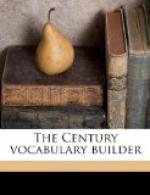The welding of these languages made available two—in some instances more than two—words for a single object or idea. What became of these duplicates? Sometimes one of the words was dropped as needless. Oftentimes, however, both were retained—with such modifications in meaning that thereafter they designated, not the same object or idea, but different forms or aspects of it. Thus they became parallels, and the new language waxed rich with discriminations which neither of the component tongues had possessed.
Scott in Ivanhoe gives the basis upon which the unification of the languages proceeded. The jester Wamba in conversation with the swineherd Gurth explains how the Anglo-Saxon term took on the homelier, rougher, more workaday uses and left the more refined and fastidious uses for the Norman-French. A domestic animal, says Wamba, was cared for by the conquered people, and in consequence bore while living a “good Saxon” name—swine, ox, or calf; but it was served at the tables of the conquerors, and therefore when ready for consumption bore a “good Norman-French” name—pork, beef, or veal. “When the brute [a sow] lives, and is in charge of a Saxon slave, she goes by her Saxon name; but becomes Norman and is called pork, when she is carried into the castle hall to feast among the nobles.... He [a calf] is Saxon when he requires tendance, and takes a Norman name [Monsieur de Veau] when he becomes matter of enjoyment.”
Let us see how Scott’s contention fares if we extend his list of terms relative to animal life. As throughout the rest of this chapter, with the single and necessary exception of List B, the first word in each pair is native, the second classic:
LIST A
sheep, mutton deer, venison horse, equine cow, bovine bull, taurine sheep, ovine wolf, lupine hog, porcine bear, ursine fox, vulpine cat, feline dog, canine fish, piscatorial mouse, vermin rat, rodent mankind, humanity man, masculine woman, feminine childish, infantile boyish, puerile
A glance at this list will show that, at least as regards animal life, the native word is likely to be the more familiar and unpretentious. But we must not leap to the conclusion that, taking the language as a whole, the simple, easy word is sure to be native, the abstruse word classic. In the following list one word in each pair is simpler, oftentimes much simpler, than the other; yet both are of classic origin. (In some instances the two are doublets; that is, they spring from the same stem.)
LIST B




